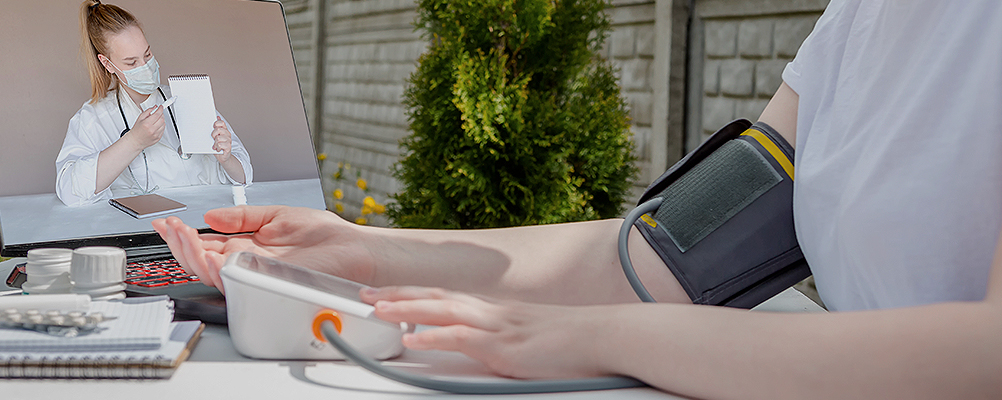
The influx of COVID-19 cases has raised several challenges for healthcare systems around the world. As hospitals are overburdened with the virus cases, realizing ‘social distance’ as a critical containment measure, healthcare experts and researchers have innovated technologies that help in monitoring patients remotely. Considering the ongoing health crisis and the requirement to deliver care more cost-effectively, Remote Patient Monitoring (RPM) technology reassures accessibility and caters to the need for safe out-of-hospital management especially for kidney failure patients. RPM technology such as Sharesource has the potential to share treatment data with clinicians at the completion of therapy daily to proactively manage the condition of Automated Peritoneal Dialysis (APD) patients.
These systems eliminate the need of in person and regular visits to the hospital for dialysis, keeping the patient away from being exposed to COVID-19 and have reduced the mental stress experienced by patients on dialysis. They also help hospitals manage their staff which is essential during the pandemic when resources are falling short to treat the growing number of COVID-19 positive patients.
In-depth understanding of RPM System
PD is a home-based treatment for kidney failure patients that uses the lining of the patient’s abdomen to filter wastes from the blood. It can be carried remotely at any clean and enclosed environment. PD is done frequently which eliminates the chance of build-up of waste and toxins in the blood. There are two kinds of PD— Continuous Ambulatory Peritoneal Dialysis (CAPD) and APD. CAPD involves carrying dialysis manually whereas APD requires a machine called cycler to deliver and drain dialysate.
Today, we also have cyclers that are embedded with RPM technology that allow clinicians to monitor the patient’s treatment on a regular basis. This allows them to make changes to the patient’s prescription if necessary, review and proactively manage any clinical issues recorded during the dialysis and allows early intervention.
While carrying dialysis at home with the help of APD, real time health data related to the patient’s dialysis condition, is well managed through the RPM system. After the completion of PD, the information collected gets automatically transmitted to a secure platform accessible by the doctor in a different location for recommendations. From the patient’s treatment history, the doctor can track events that may have flashed certain issues during the dialysis and make clinical decisions in a more-timely manner. Considering the nature of the disease, kidney failure patients require different settings for each therapy session. Using the remote monitoring system, doctors can now customise dashboards that can be organised as per individual patient needs.
How is RPM redefining renal care in India?
As a part of telehealth, RPM provides virtual and continuous connection between the patient and the doctor. Telehealth as defined by the WHO, is the use of virtual technology and telecommunications to deliver healthcare facilities, going beyond the traditional way. As per reports, the global telehealth market is expected to reach $55.6 billion by 2025 from USD 25.4 billion in 2020. The rapid increase in prevalence of chronic diseases, shortage of healthcare infrastructure, the need to make healthcare accessible to all and advancement in medical technologies are the major driving factors for the growth in telehealth services in the last three decades.
The growing use of remote technologies has helped the population that has witnessed disproportionately high rates of chronic diseases and barriers such as inflexible work schedules, limited transportation, and financial crunches. When people learn that their kidney has lost its ability to function and dialysis becomes a necessity, the instinct is to get it, even if it entails out-of-pocket expenses. This pushes families into incurring expenses beyond their means. The long-term costs are lower of RPM technology that comes with APD, as it allows smooth and efficient treatment from the comfort of home and helps in proactive management of kidney failure patients reducing the need of emergency hospitalizations.
With two lakh kidney patients who require 34 million dialysis therapy in total every year, India has many battles to fight to address this burden, at a time like this. Fortunately, today, we are observing an onslaught of technologies that are aiding in managing kidney diseases better, giving respite to millions of patients. However, their usage remains abysmally low due to lack of awareness. As per current estimates, there are about 6,500 patients on PD in India. Hence, there is a dire need to address the treatment barriers kidney patients’ face by spreading awareness and giving patients access to much-needed RPM technologies that will define the future of healthcare in India.
Source: TIMES OF INDIA
